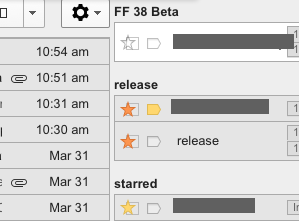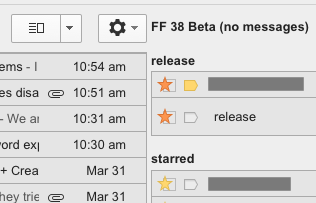GMail multi-inbox
As much as GMail’s search syntax makes me long for PCRE, there are some unobvious gems laying around.
For example, I get tons of mail about releases. Occasionally, I need to monitor a given release, paying attention to not only the automated progress, but also human generated emails as well. Here’s my current setup:
- Automated email is marked as read & skips inbox (unless it’s a failure)
- Any release oriented email is given a special label using a filter similar to “subject:((38.0b1) OR (38 Beta) OR (31. AND "esr")”.
That’s pretty standard. The productivity add is when I use the “multi-inbox” feature in the web ui. I set the top one to be just the unread ones with the special label from today:
newer_than:1d label:SPECIAL_LABEL is:unread
With positioning of “extra panels” to the right side, I get a very focussed look at any issues I need to look at!
Messages:

No Messages:

I love seeing that “(no messages)” text!
Docker at Vungle
Tonight I attended the San Francisco Dev Ops meetup at Vungle. The topic was one we often discuss at Mozilla - how to simplify a developer’s life. In this case, the solution they have migrated to is one based on Docker, although I guess the title already gave that away.
Long (but interesting - I’ll update with a link to the video when it becomes available) story short, they are having much more success using DevOps managed Docker containers for development than their previous setup of Virtualbox images built & maintained with Vagrant and Chef.
- Vungle’s new hire setup:
- install Boot2Docker (they are an all Mac dev shop)
- clone the repository. [1]
- run docker.sh script which pulls all the base images from DockerHub. This one time image pull gives the new hire time to fill out HR paperwork ;)
- launch the app in the container and start coding.
Sigh. That’s nice. When you come back from PTO, just re-run the script to get the latest updates - it won’t take nearly as long as only the container deltas need to come down. Presto - back to work!
A couple of other highlights – I hope to do a more detailed post later.
- They follow the ‘each container has a single purpose’ approach.
- They use “helper containers” to hold recent (production) data.
- Devs have a choice in front end development: inside the container (limited tooling) or in the local filesystem (dev’s choice of IDE, etc.). [2]
- Currently, Docker containers are only being used in development. They are looking down the road to deploying containers in production, but it’s not a major focus at this time.
Footnotes
| [1] | Thanks to BFG for clarifying that docker-foo is kept in a separate repository from source code. The docker.sh script is in the main source code repository. [Updated 2015-03-11] |
| [2] | More on this later. There are some definite tradeoffs. |